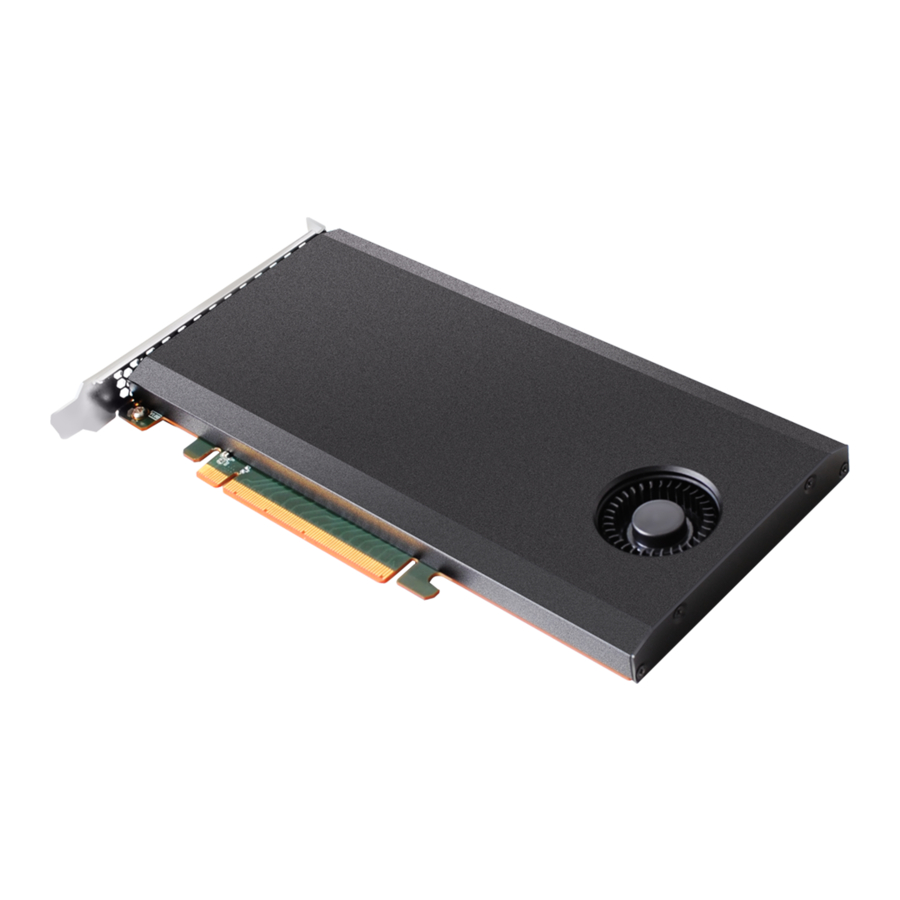
HighPoint SSD7103 Installation Manual
Boot raid windows
Hide thumbs
Also See for SSD7103:
- Installation manual (13 pages) ,
- Quick installation manual (9 pages) ,
- Installation manual (11 pages)
Subscribe to Our Youtube Channel
Summary of Contents for HighPoint SSD7103
- Page 1 SSD7103&SSD7202&SSD7505&SSD7540 Boot RAID Windows Installation Guide V1.01– Oct 2020...
-
Page 2: Table Of Contents
Prerequisites for a Bootable RAID Configuration ..................3 UEFI BIOS Settings ............................4 How to install Windows to the SSD7202/SSD7103/SSD7505 /SSD7540 RAID Controller ..... 6 Step 1 - Preparing the USB Flash Drive ....................6 Step 2 - Preparing the UEFI Package ...................... 6 Step 3 - Creating the RAID Array ...................... -
Page 3: Prerequisites For A Bootable Raid Configuration
SSD7202/SSD7103/SSD7505 2. RAID controller. 3. A PCIe 3.0/4.0 slot with x8 or x16 lanes. The SSD7202, SSD7103 or SSD7505 , SSD7540 must be installed into a PCIe 3.0/4.0 slot with x8 or x16 lanes. 4. Your motherboard must have a UEFI BIOS with option ROM settings for third party devices (such as the SSD7202/SSD7103/SSD7505/SSD7540, optical drives and USB flash drives). -
Page 4: Uefi Bios Settings
Scroll to the Boot tab and set the "Boot Mode Select" to "UEFI"; Under "Advanced->PCIe/PCI/PnP Configuration->, change “CPUx Slot x PCI-E OPROM" to "EFI". “x” represents the PCIE slot assignment. For this example, the SSD7103 is installed into “CPU1 Slot 1”. - Page 5 Disable "Secure Boot", and set "Attempt Secure Boot" to "Disabled". Example 2: Changing the UEFI setting (ASUS PRIME X299 –DELUXE): a. Boot the system and access the motherboard’s BIOS menu. b. Set "Boot from Storage Devices" to "UEFI driver first"; Set "Boot Device Control"...
-
Page 6: How To Install Windows To The Ssd7202/Ssd7103/Ssd7505 /Ssd7540 Raid Controller
How to install Windows to the SSD7202/SSD7103/SSD7505 /SSD7540 RAID Controller Note: The following installation process uses the SSD7103 as an example Step 1 - Preparing the USB Flash Drive When preparing the USB flash dive, make sure to format the USB partition as FAT32. If another file system is used, the USB drive may not be properly recognized, and will not appear as an option under the motherboard’s UEFI BIOS menus. -
Page 7: Step 3 - Creating The Raid Array
Step 3 - Creating the RAID Array a. This procedure assumes you have already installed NVMe SSD’s into the SSD7000 controller (please see Step 1- Prerequisites). Note: Make sure your USB flash drive has been formatted using the FAT32 file systems. b. - Page 8 f. Next, enter the following command to enter the RAID creation utility: ArrayCreate.efi g. Next, create the array using the following command: create RAID0 This will create a RAID0 array using all of the SSD’s, and configured for maximum capacity: h.
-
Page 9: Step 4 - Install Windows
Install Windows, to “Where do you want to install Windows?”, you should see several Legacy disks available (one for each SSD you have installed into the 7540 SSD7202/SSD7103/SSD7505/SSD controller). Note: The screenshot below shows 4 SSD’s that have been installed into a SSD7103 controller:... - Page 10 Click “Load driver”,in the pop-up window and click “Cancel”: f. Next, insert the USB flash that contains the SSD7202/SSD7103/SSD7505 driver into the motherboard USB slot and click “Browse”. Select the driver file as shown:...
-
Page 11: Step 5 - Disabling Hibernation
g. After loading the driver, return to the “Where do you want to install Windows?” interface. The previous Legacy disks will now be recognized as a RAID array: h. After partitioning, continue and complete the Windows installation procedure. Step 5 - Disabling Hibernation a. - Page 12 Please use administrator privileges to turn off hibernation using the following command (Command Prompt utility): #powercfg /h off Enter the command to check that the quick shutdown is turned off; powercfg / a...
-
Page 13: Trouble Shooting
Trouble shooting Command error in UEFI In the UEFI environment, run the command prompt "No supported controller detected" Solution : Check whether the Storage option ROM is Enabled in the motherboard BIOS. Replace the motherboard slot, enter the UEFI environment and re-enter the command. -
Page 14: Appendix
Appendix Support command: help/info/quit/exit/create/delete. Ÿ Create Command Syntax Create Array Type (RAID0/RAID1) Member Disk list (1/1,1/2|*)Capacity(100|*) Examples <<< create RAID0 <<< create RAID0 * <<< create RAID0 * * Create RAID0 array with all disks and with maximum capacity. <<< create RAID1 1/1, 1/3 10 Create RAID1 array with disk 1/1 and 1/3 and with 10GB capacity. - Page 15 Display physical device list and logical list Ÿ Exit Command Syntax Q/q/quit/exit Quit the application Ÿ Help Command Syntax H/h/help This is help message...

















Need help?
Do you have a question about the SSD7103 and is the answer not in the manual?
Questions and answers